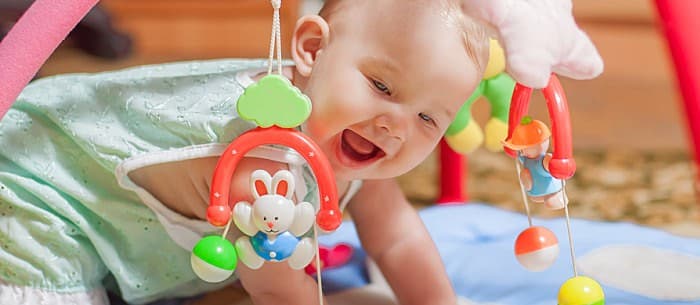So you have a new baby at home, and you’re wondering, “What kind of activities for babies can I use to keep this little guy entertained?” He’s a smiling, drooling, squishy, pint-sized version of you — a blank slate waiting to learn and grow from your input. And whether you choose to do this through babbling baby talk or playing endless games of peekaboo, you might still ask yourself: Do babies really need such activities to learn and develop.
According to Dr. Gail Gross, a psychologist and family and child behavior specialist, learning through activities starts from day one. Humans are born with very underdeveloped brains, so it’s up to parents to stimulate their baby’s mental growth with emotional and physical attention. Your little one begins to develop a personality and learn language almost immediately after birth, in large part because of parental interaction.
“It is through the day-to-day activities of caring for your child that you have the greatest opportunity to influence your child’s brain growth,” says Dr. Gross.
- Teach Baby Through Activities
From birth, babies are like sponges: They take in everything. They learn from our voices, our touch and our smell. And in turn, tasks as small as changing diapers can be educational activities for babies — let your baby touch the clean diaper, talk to your baby about his body as you touch his legs and feet and get him familiar with the routine!As they get older and move out of infancy and into babyhood, it’s still social and emotional interaction that really counts, which can be done in the form of play. Keep in mind that you don’t need to read up on the latest trends or spend lots of money on fancy toys, says Dr. Gross. She suggests starting simply, providing objects for your baby to observe and manipulate in a safe environment, such as blocks and balls. You can sit with him and interact in the play so he feels secure and encouraged to engage.
- Let Baby Learn Through Self-Play, Too
Structured activities for babies aren’t the only way to encourage play. Developmental psychologist Nancy S. Buck says that learning can also happen through self-play. “If parents are willing to leave their child alone in a safe place,” she says, “whether that be a … crib or on the floor in a safe and contained area, eventually the child will begin to get curious, exploring and playing with her surroundings, including her own body.” If you do leave the room, stay within ear shot and take a baby monitor with you.Babies always find a way to be active and learn, whether it’s with a parent or through self-play. Think of how a baby can spend nearly 20 minutes inspecting his own hands. He’s perfectly capable of entertaining himself, and while it may seem like he’s not learning anything from this activity, he most certainly is — he’s developing a sense of himself and his surroundings.
- Read Baby’s Cues
So how do you know if your baby is in the mood to play? If your baby is awake, alert and tracking you with his eyes, this means it’s time to play with him. But always take the time to read your baby’s body language — he’ll tell you if he wants to continue playing or if he’d rather be left alone. If your baby is happy and babbling, it’s probably a sign that your current activity can continue. On the other hand, the classic sign that a child is overstimulated or tired is that he begins to cry or fuss, says Buck. This is the child’s way of saying, “I’m done with this now. Let’s do something different, like eat, or you hold me or put me to bed to sleep.”
In the end, parents know best what their baby needs to grow and learn, so every opportunity for play is what you make of it. The options for activities with babies are as endless as a parent’s imagination.
For more on baby development, read How to Keep Your Little One Stimulated.
Christina Montoya Fiedler is a Los Angeles-based parenting writer and mother of two boys. Read her bylines at BabyCenter, Red Tricycle and CafeMom. Follow her on twitter.






